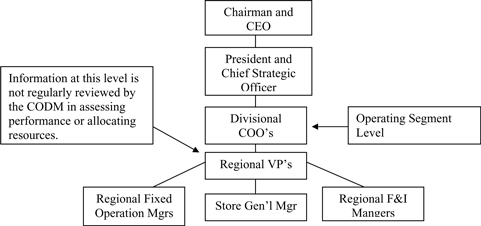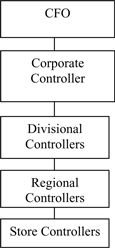
November 9, 2007
Mr. Robert Babula
United States Securities and Exchange Commission
Division of Corporation Finance
100 F. Street, NE
Washington, D.C. 20549
Re: Sonic Automotive, Inc. – Comment Letter dated September 28, 2007
Dear Mr. Babula:
Sonic Automotive, Inc. is submitting the following responses to comments received from the Staff of the Division of Corporation Finance in its letter dated July 26, 2007. For your convenience, the Staff’s comments have been reproduced in bold faced type before each response in this letter.
Overview, p25
| 1. | We note your response to comment 2 of our letter dated July 26, 2007. Please explain in detail how senior management allocates resources of the Company. In this regard, you indicate that you have operating segments which are defined by geographic regions, although the reports which the CODM Group review contain detailed information down to the regional level (e.g. Alabama, North Los Angeles and Houston). Please explain in detail why you do not consider regions as operating segments pursuant to paragraph 10 of SFAS no. 131. Furthermore, please provide three years of comparable revenue, profit (loss) and margin history, and asset information for each region. Based on the information provided to us it appears the regions identified in your CODM materials are not economically similar. See EITF Issue 04-10 regarding guidance on aggregating operating segments. We may have further comment. |
Senior management allocates the resources of the Company using consolidated balance sheet, income statement and cash flow data. Acquisitions and capital expenditures decisions are made using consolidated balance sheet and cash flow information. The senior management team is compensated based on consolidated Company results, not regional results.
We are first and foremost a sales organization so one of the most significant resource allocation decisions made by our CODM groups relates to the organization and chain of command of our associates. The CODM group accomplishes this using the matrix organization described in our previous response and in more detail below. The CODM group directs the resource allocation but relies on our Divisional COO’s to place the most appropriate personnel in the regional and dealership positions under their span of control.
The Company’s field management structure is based on the need for close oversight and management proximity and is not due to any special economic circumstances at any location. The field management structure generally manages day-to-day operations and executes Company-wide initiatives in a standardized fashion as envisioned by the senior management of the Company. Examples of these management practices are as follows:
| • | centrally controlled dealer management and other systems utilized by the stores; |
| • | centralized cash management, floorplan financing, lease financing and capital markets activity; |
| • | standardized accounting policies and procedures; |
| • | common compensation plans; |
| • | centralized capital expenditure plans; |
| • | negotiation of national purchasing contracts to the extent possible; |
| • | centralized store acquisition and divestiture plans; |
| • | standardized finance and insurance sales practices; and |
| • | standardized used vehicle sales processes. |
At your request, we will supplementally provide the regional information requested by the Staff. However, we wish to emphasize that the information requested is not reviewed by the CODM and thus was not considered relevant for the purpose of our determination of operating segments under SFAS 131.
We believe, after considering the guidance provided in SFAS 131, the organizational structure of the Company and the information reviewed by the CODM groups that our geographic divisions represent operating segments. We do not believe our geographic regions represent operating segments as contemplated by paragraph 10 of SFAS 131, “Disclosures about Segments of an Enterprise and Related Information”, for the following reasons:
| A. | There are no regional managers reporting directly to the CODM. |
Paragraph 14 of SFAS 131 states, “Generally, an operating segment has a segment manager who is directly accountable to and maintains regular contact with the chief operating decision maker to discuss operating activities, financial results, forecast or plans for the segment.”
Following is a partial organization chart for Sonic Automotive’s field operations which indicates that there are no regional operations managers reporting directly to the CODM (Sonic’s CODM is a group comprised of the CEO, President and CFO):
2

Following is a partial organization chart for Sonic Automotive’s finance operations which indicates that there are no regional financial managers reporting directly to the CODM (Sonic’s CODM is a group comprised of the CEO, President and CFO):

3
| B. | The market information noted by the Staff does not correspond to the regions for which our regional managers are responsible. |
The Staff noted in our previous response that certain “regional” information was included in the financial package supplied to the CODM group. Please note that the correct term for the geographic units detailed on those reports should be “markets” since our operating group defines regions as those geographic areas that have the regional personnel described in the chart above (RVP, Regional Controller, Regional F&I, etc.).
The vast majority of the information reviewed by the CODM which was previously provided to the Staff reflects consolidated balance sheet and income statement analyses. Some high-level summary statistics are provided for our markets on both a consolidated and a same store basis. As previously indicated, these reports are distributed to and used by more than the CODM group and for purposes other than resource allocation and performance evaluation. The market information included in these reporting packages is used primarily by our financial reporting staff in preparing our MD&A. This information is included in the package that is used by the CODM group simply to avoid the inefficiencies of having to publish multiple customized reporting packages.
As demonstrated by the following chart, there are significant differences between the operating regions which are under the control of our Divisional COO’s and the markets that the financial reporting group uses to analyze high-level trends for MD&A purposes:
| Regions with Regional VP Oversight |
Markets Used in Reporting Package | |
| Northern CA |
North Bay | |
| South Bay | ||
| Southern CA/Las Vegas |
North LA | |
| South LA | ||
| San Diego | ||
| Las Vegas | ||
| OK/CO |
Oklahoma | |
| Colorado | ||
| Texas |
Houston | |
| Dallas | ||
| NC/SC/GA |
NC/SC/GA | |
| Florida |
Florida | |
4
| AL/TN |
AL/TN | |
| OH/MI/Mid-Atlantic |
Ohio | |
| Michigan | ||
| Mid-Atlantic | ||
We would also point out the fact that, although the regions with RVP oversight listed above have since changed again in 2007 (the above chart reflects the status for the 2006 reporting year), the markets included in the financial reporting package have very rarely changed. This is because this high-level market information is not used by the CODM group to assess performance and allocate resources but, rather, is used by the financial reporting group to identify trends worth highlighting in the Company’s MD&A.
| C. | Our regional structure is for administrative purposes rather than for resource allocation and performance evaluation purposes. |
Our regional structure has gone through numerous revisions. Over the years, we have gone from 13 regions down to 7 regions. Even in periods where the overall number of regions hasn’t changed, the geographic footprint of each region has changed significantly. For instance, our Oklahoma dealerships have alternatively been part of our TX/OK region and part of our OK/CO/NV region. Our Nevada dealerships have alternatively been part of our OK/CO/NV region and part of our NV/SoCA region.
These changes were not made for resource allocation purposes but rather were made based on our Divisional management’s assessment of the management strength of the regional teams in place at that time. These changes were made with minimal or no disruptions to dealership operations, strategies or execution which demonstrates that the field management structure is based on obtaining the proper management support and oversight for the dealerships.
As the Company continues to evolve, a completely different structure may be designed to meet the Company’s requirements. This flexibility in structure is made possible since the Company’s store operations are not affected by changes in the field management structure.
| D. | The regional or market data reviewed by our CODM group is not comprehensive enough to be used to assess performance or allocate the resources of the Company. |
The Staff has noted the inclusion of certain market information in the financial package supplied to the CODM group, among others and has correctly questioned whether this information is indicative of the fact that the CODM group uses information below the divisional level (our current operating segments) to assess performance and allocate resources. We do not believe this information is comprehensive enough to be used by our CODM group for making management decisions for a Company the size of Sonic Automotive.
We reached this conclusion based on our review of the information used by our Divisional staff, who are responsible for assessing the performance of the regions under their span of control. We noted that the information utilized by our Divisional staff is significantly more comprehensive than the market information included in the reporting package reviewed by the
5
CODM. Examples of information reviewed by our Divisional staff are as follows (note that this is not a comprehensive list):
| • | Inventory days supply by dealership under their span of control; |
| • | Budget vs actual by dealership within each region; |
| • | Gross profit per unit by model; |
| • | SG&A detail by dealership within each region; |
| • | Advertising expense vs budget by dealership within each region; |
| • | Service loaner trends; |
| • | 13 month trend for warranty repair work by brand; |
| • | Parts days supply by dealership within each region; |
| • | Hours per repair order by dealership within each region; and |
| • | F&I product penetration. |
If the CODM group was assessing performance and allocating resources at a level below the divisional level, it stands to reason that they would be reviewing the same level of detail that our divisional managers use when assessing performance at this lower level.
The determination of operating segments is a subjective evaluation based on the information which is reviewed, how that information is used and the organization of the Company. We believe the organizational structure of Sonic Automotive, the standardization of many process and decisions regardless of geography and the comprehensive information which is reviewed by those directly responsible for the performance of our regions more than offsets any summary market information which may be included in a reporting package which is available to the CODM group but is used primarily by a broader group of internal personnel.
In connection with submitting these responses, the Company acknowledges the following:
| • | It is responsible for the adequacy and accuracy of the disclosure in the filing; |
| • | Staff comments or changes to disclosure in response to Staff comments do not foreclose the Commission from taking any action with respect to the filing; and |
| • | The Company may not assert Staff comments as a defense in any proceeding initiated by the Commission or any person under the federal securities laws of the United States. |
Please feel free to call Greg Young, the Company’s Chief Accounting Officer, with any questions at 704-566-2489.
6
Yours truly,
SONIC AUTOMOTIVE, INC.
| /s/ Stephen K. Coss |
| Stephen K. Coss |
| Senior Vice President, General Counsel and Secretary |
| cc: |
David P. Cosper | |
| Greg D. Young | ||
| Thomas H. O’Donnell, Jr. |
7